A slow-draining shower often leaves homeowners standing ankle-deep in cloudy water, watching soap scum drift around their toes. When the drain backs up or unpleasant smells rise from below, it is easy to feel frustrated and reach for harsh chemicals.
Fortunately, anyone can safely Clean Shower Drain blockages without toxic cleaners by using simple household items like baking soda and vinegar. This guide offers clear instructions on eco-friendly solutions that unclog stubborn drains while protecting the family’s health.
Keep reading to solve this pesky problem for good.
Key Takeaways
- Using baking soda and vinegar provides an effective, chemical-free solution for clearing shower drain clogs; pour 1/3 cup baking soda followed by equal parts vinegar, let it fizz for at least 30 minutes, then flush with hot water.
- Regularly flushing drains weekly with very hot water prevents small buildups and helps reduce unpleasant odors without damaging pipes.
- Household tools like plungers or plumber’s snakes (drain augers) safely remove stubborn hair and debris from clogged drains instead of using toxic cleaners.
- Installing drain hair catchers stops future clogs by trapping loose hairs before they enter the pipe system; homeowners should clean them frequently to keep drains flowing smoothly.
- Always identify your pipe material first boiling hot water can safely clear metal pipes but may warp or damage PVC plumbing.
Considerations Before Cleaning Your Shower Drain

Before diving headfirst, take a quick look at what you are up against in the drain. Grab everything you will need upfront it saves fussing around later.
Assess the type of clog
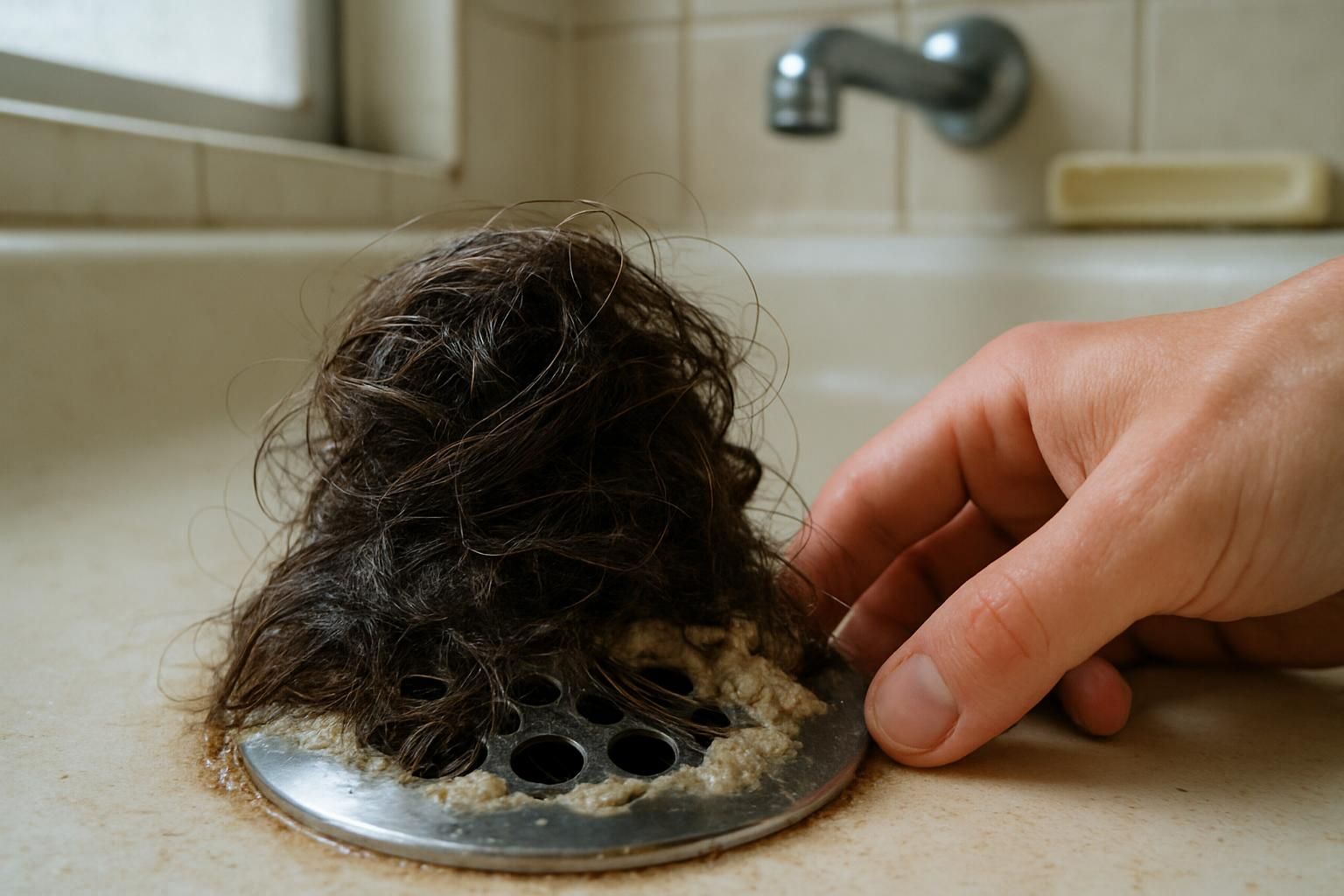
Assessing the blockage helps homeowners tackle shower drain problems effectively. Hair buildup often creates obstruction, resulting in standing water or slow drainage. Soap residue mixes with grease and dirt to form tough accumulations inside pipes over several weeks or months.
Mineral deposits from hard water can also cause congestion that slows draining significantly. Rarely, tree roots invade underground pipes, creating severe backup issues that may require professional intervention.
Gather necessary tools and materials
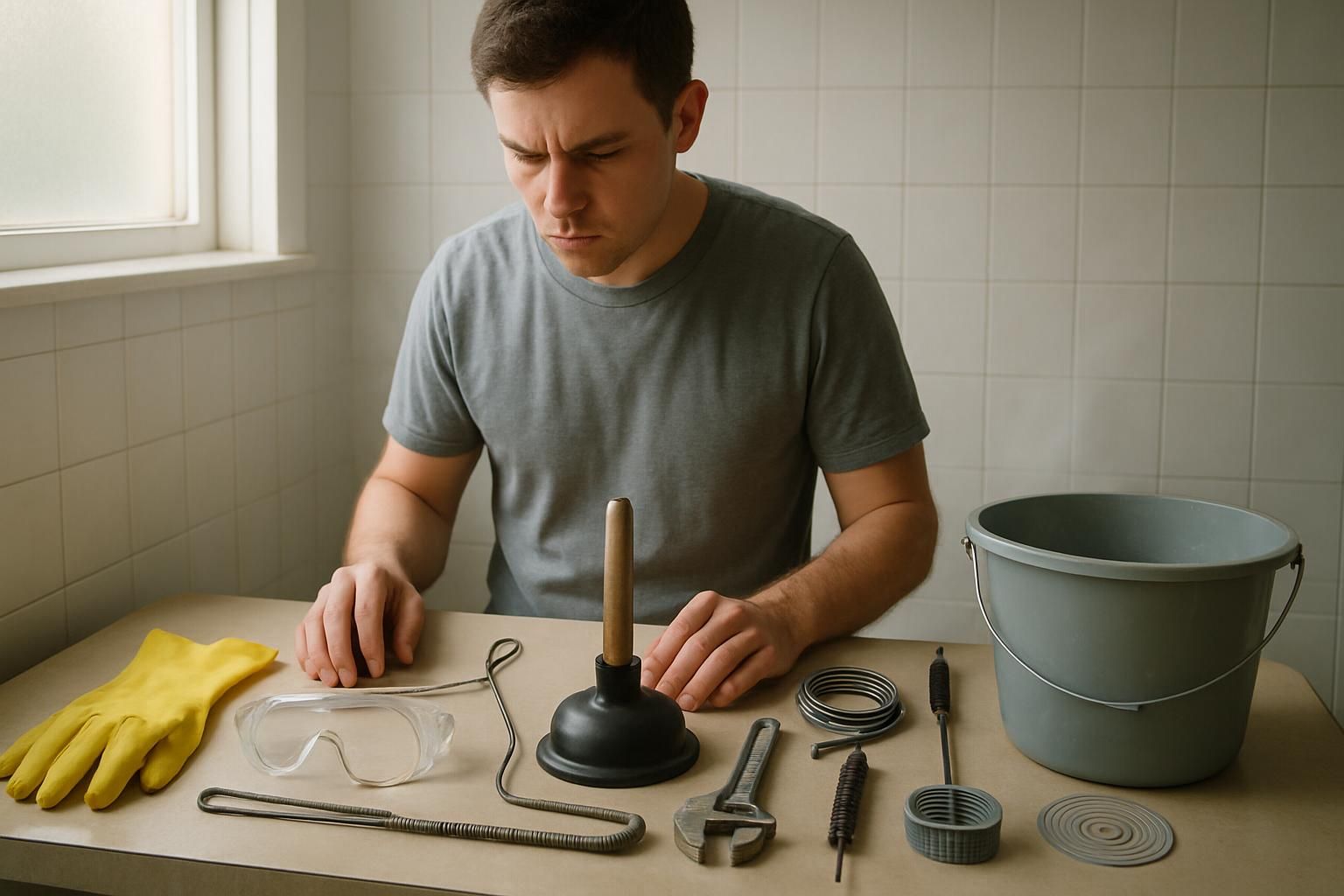
Before getting started, gathering the correct tools makes cleaning the shower drain quick and safe. Basic items around the house help homeowners clear drains without harsh chemicals.
- Protective gloves shield hands from germs and sharp objects when removing clogs.
- Eye goggles offer safety against splashing water or debris during cleaning.
- A straightened wire coat hanger works well for pulling out visible hair strands.
- A sturdy plunger creates strong suction to loosen stubborn blockages fast.
- A plumber’s snake, sometimes called a drain auger, reaches deep into pipes to remove tough clogs easily.
- Drain snakes usually come in lengths of 25 to 50 feet and bend through tight pipe curves.
- An adjustable pipe wrench grips tightly onto metal drain covers to unscrew them smoothly without damage.
- Simple plastic drain brushes scrub away grime buildup inside pipes close to the surface area.
- Installing a drain hair catcher, also known as a tub strainer or drain stopper, prevents future hair build-up effectively.
- Keep a bucket nearby to catch dirty water and waste pulled from clogged drains for simple clean up afterward.
Clear Visible Blockages
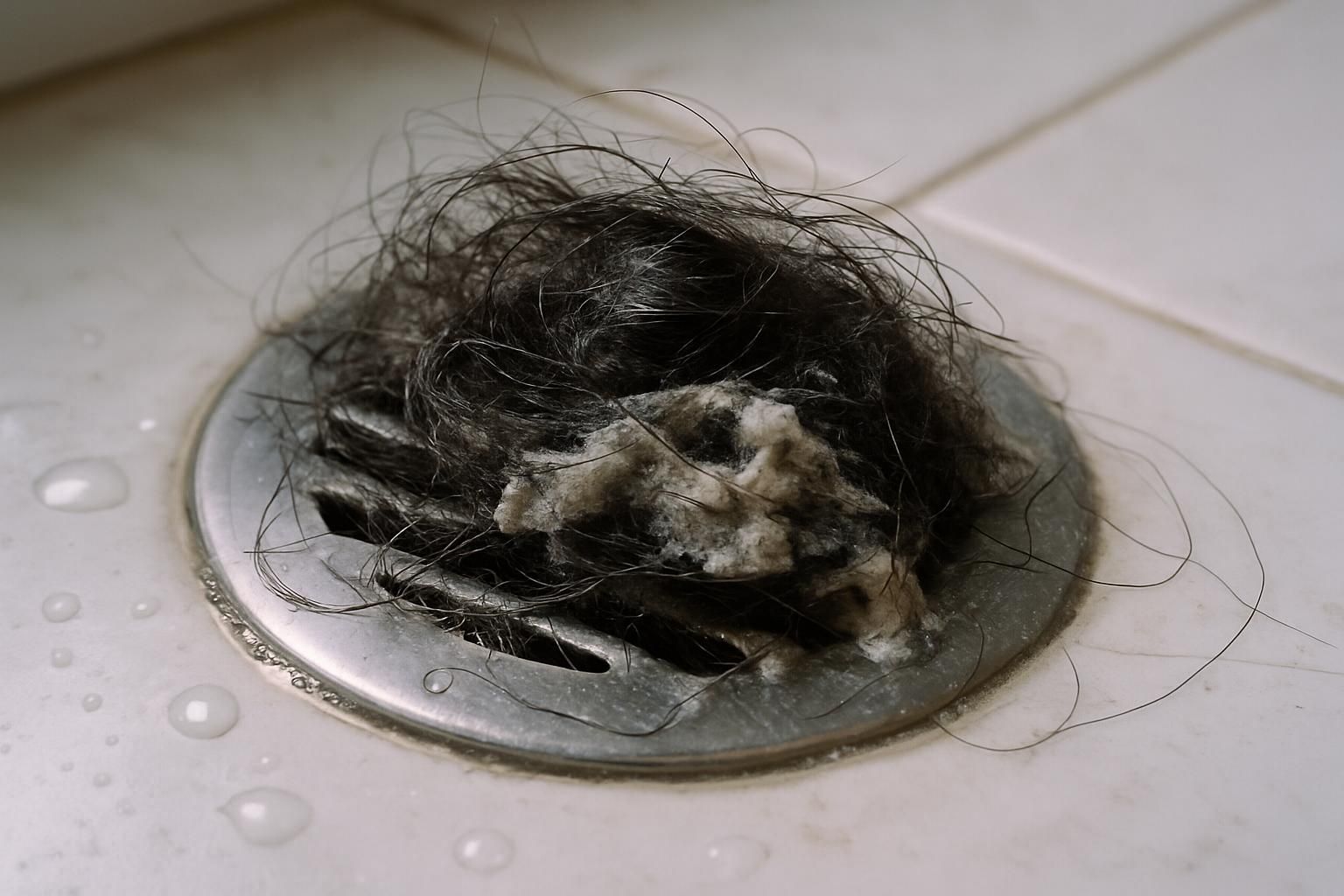
No one likes pulling gunk out of their shower drain, but it is the first step to smooth drainage. Grab some gloves and get ready this will be messy but oddly satisfying.
Remove the drain cover
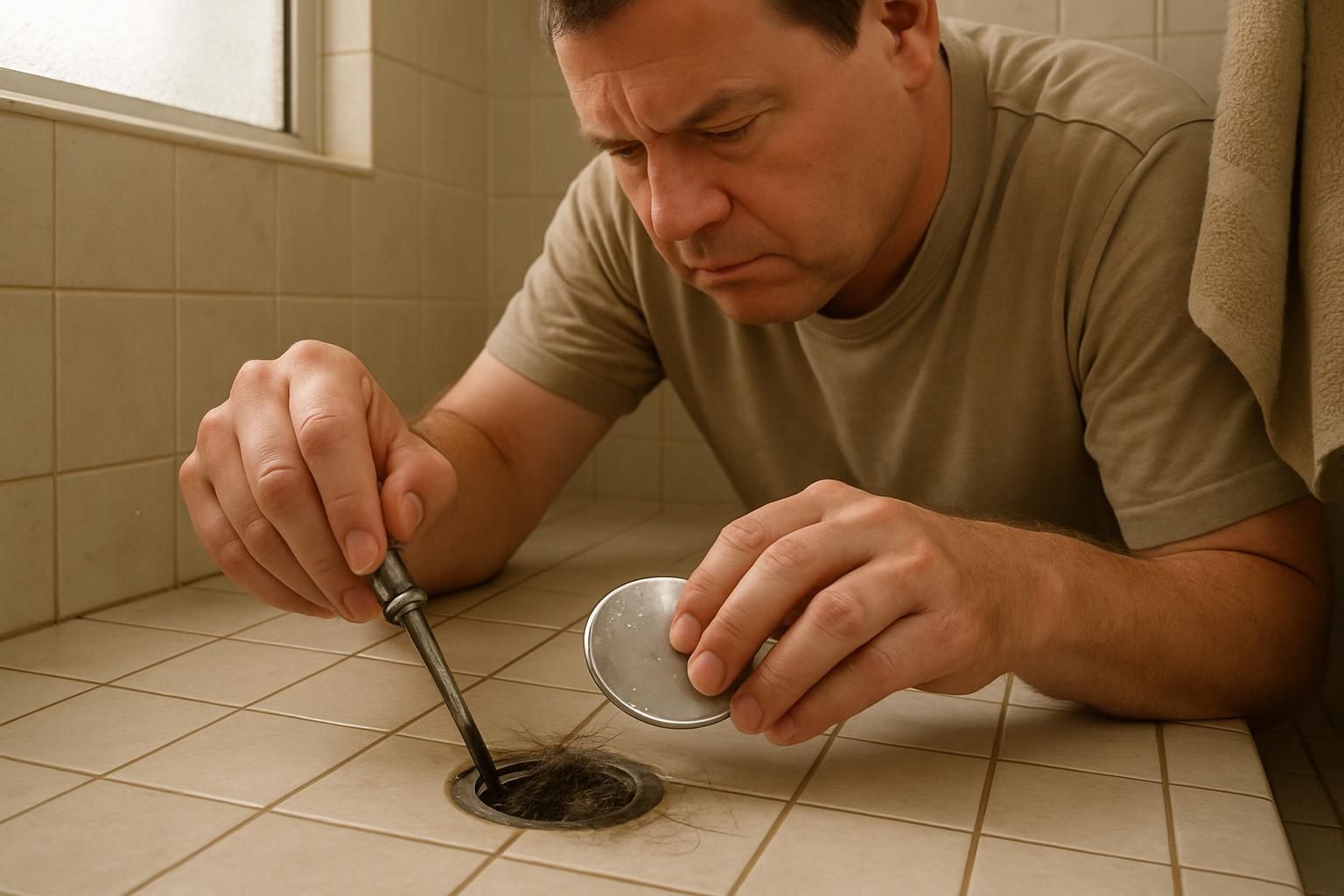
Removing the drain cover is step one for clearing visible obstructions. Most shower drains have covers held by screws or simply snapped in place. A homeowner should carefully unscrew or gently pry up the drain cover using an appropriate tool, like a screwdriver, to avoid scratching the surface.
After opening the drain cover, easy access to debris and hair becomes possible for thorough cleaning and blockage removal. Setting aside the drip-covered piece safely ensures it does not get misplaced or damaged.
After completing these tasks later on, replacing this cover securely prevents any accidents while showering.
Pull out hair and debris
After removing the drain cover, cleaning becomes simple. Homeowners can easily pull out hair and debris blocking the shower drain by hand or with a straightened wire coat hanger. To eliminate visible obstructions fast, carefully lift any trapped strands of hair near the surface. Dispose of waste properly after clearing out blockages to avoid messy cleanup later on.
Use Boiling Water to Flush the Drain
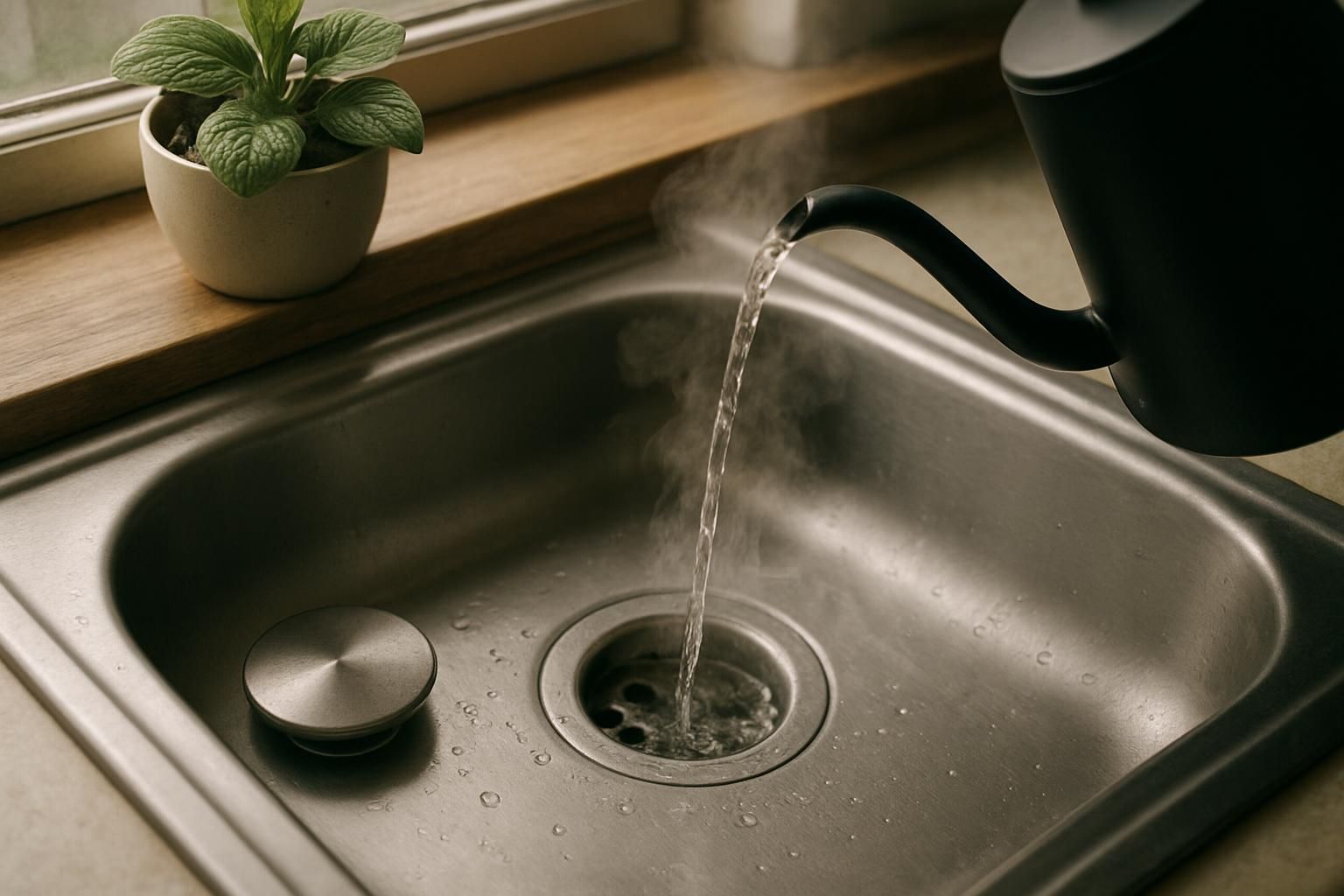
Hot water can melt away minor clogs without a drop of nasty chemicals. It is the quickest fix in your cleaning toolkit and costs almost nothing.
Boil water safely
Boiling water safely is key for effective drain cleaning. A sturdy pot with a secure handle helps prevent scalds or spills during boiling. Once boiled, pour the water slowly down the shower drain to flush dirt and debris effectively. Homeowners must verify that their pipes are metal before using boiling water, as this gentle drain unclogging technique is best suited for metal pipes. This hot water treatment works great on drains with metal pipes but can harm PVC pipes due to high heat.
Slowly pour water down the drain
Homeowners can slowly pour water down the drain in a steady stream. Pouring hot water gradually helps clear blockage and improves drainage without harming plumbing pipes. Do not pour boiling-hot liquids into PVC pipes, as extreme heat may warp or damage them. Instead, use warm but safe temperatures for household chores and DIY drain unclogging fixes around the home.
Clean with Baking Soda and Vinegar
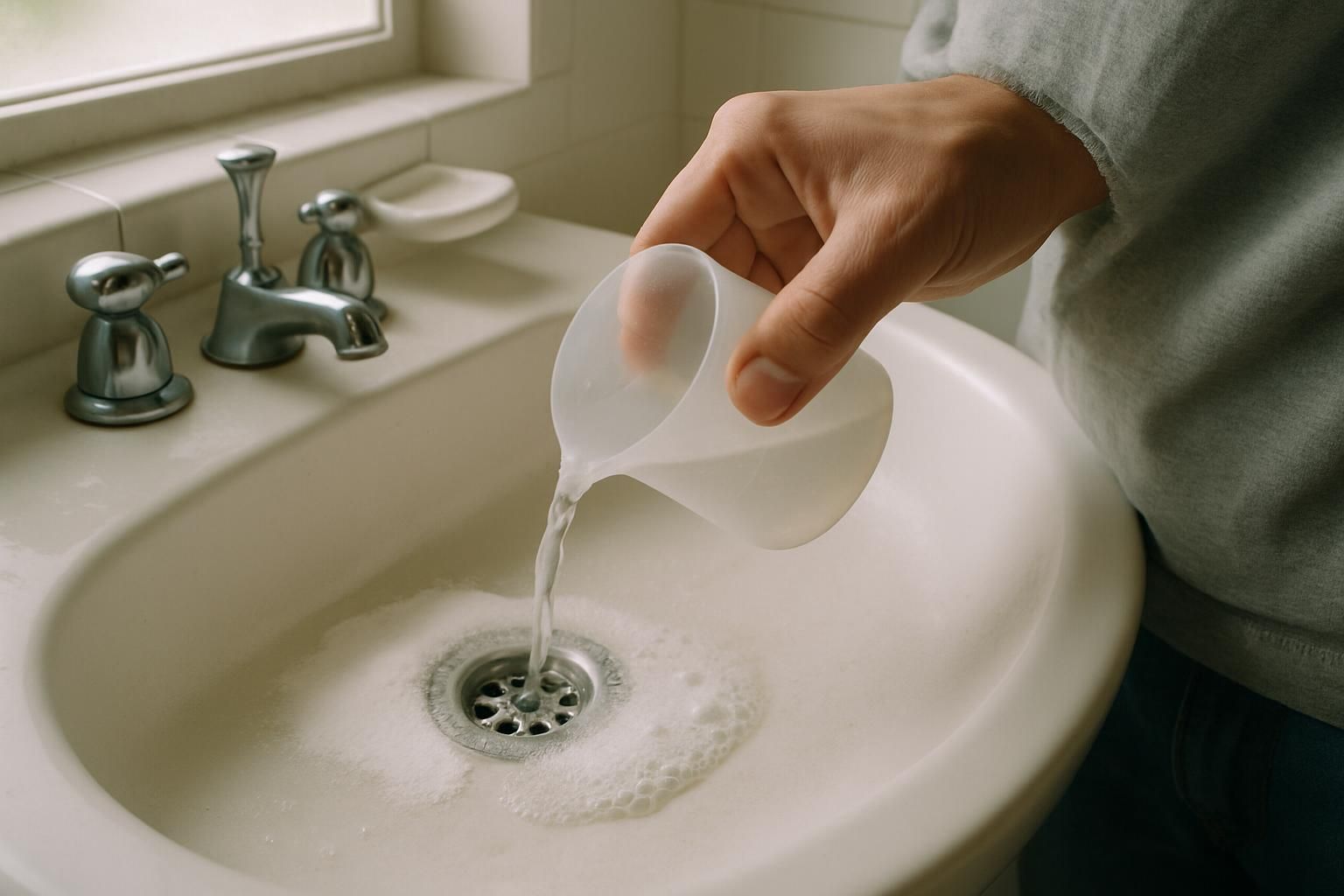
Baking soda and vinegar make a powerful, bubbly duo for tackling stubborn drain clogs. With these pantry basics, homeowners can unclog shower drains without harsh chemicals.
Add baking soda into the drain
For eco-friendly cleaning, the homeowner can begin by pouring 1/3 cup baking soda straight into the shower drain. This natural household cleaning product loosens grime and buildup gently without using harsh chemicals. Next, pour an equal amount of vinegar 1/3 cup down after it. The mixture quickly foams up to help break through stubborn clogs naturally and safely. Covering the drain and waiting at least 30 minutes allows this DIY cleaning solution time to do its job effectively before flushing with hot water. This method offers a natural drain cleaning alternative that uses a baking soda and vinegar drain cleaner approach and supports eco-friendly drain unclogging.
Pour vinegar and cover the drain
Vinegar acts as a natural cleaning solution for shower drains. After adding baking soda into the drain, pour one cup of white vinegar directly afterward. It makes bubbles and hissing sounds as it clears away gunk and grime stuck to pipe walls. Let this eco-friendly cleaning duo sit covered for at least 1 hour before moving on to the next step flushing with hot water.
Flush with hot water
Flushing with hot water is the final step in cleaning a drain using baking soda and vinegar. After leaving them to react for around 20 to 30 minutes, homeowners should pour hot water carefully down the drain. This rinses away any remaining debris, helps maintain clear pipes, and removes unwanted odors naturally. To keep drains odor-free and prevent clogs, regularly flushing weekly with boiling water proves effective. For ongoing maintenance, homeowners can pour one cup of baking soda followed by one cup of vinegar monthly into their drains.
Simple natural routines like these support eco-friendly household maintenance while protecting home plumbing long-term.
Unclog the Drain with a Plunger
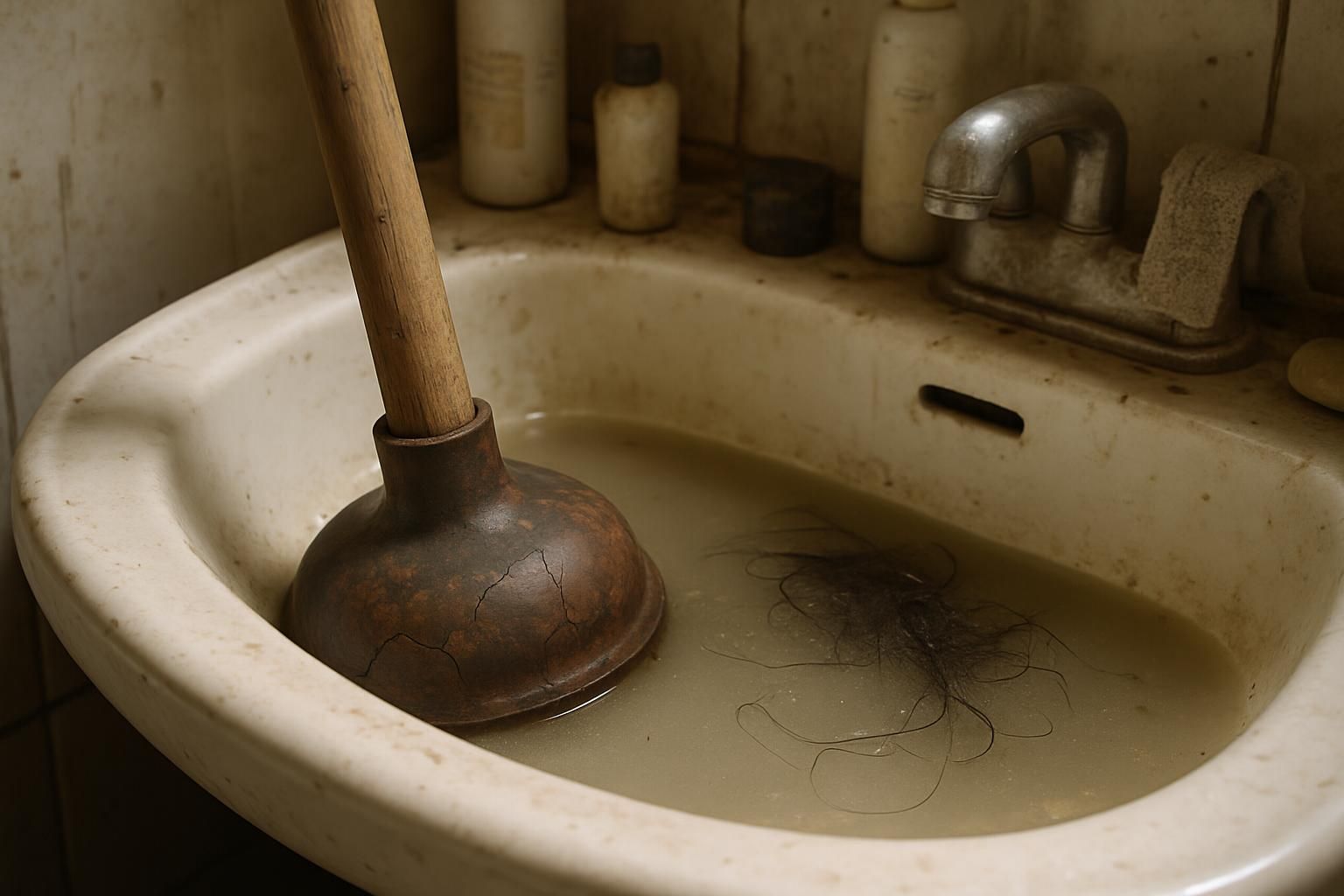
Sometimes, the good old plunger can be your best buddy in a drain crisis. A few firm pumps is usually all it takes to send that stubborn clog packing down the pipes.
Fill the shower with water
Filling the shower with water above the plunger bell creates a good seal. A solid water seal helps unclog the drain effectively and keeps air from escaping. Homeowners can pour enough water to fully submerge just the bottom rim of their plumbing tool, which makes suction quicker.
Position the plunger and create suction
The homeowner applies petroleum jelly along the cup edge of the plunger. This creates a tight seal and strong suction force over the clogged drain for effective clearance. The person grips firmly and plunges several times up and down while maintaining contact with the surface to unblock stubborn pipe blockages. Fast movements help dislodge trapped debris that disrupt water flow in household plumbing systems. Once complete, homeowners move on to using a drain snake for deeper clogs.
Use a Drain Snake to Remove Deep Clogs

Sometimes, a clog hides deeper in the pipes, beyond what eyes can spot. In that case, grabbing a drain snake often does the trick it is simple to learn and oddly satisfying to use!
Insert the snake into the drain
The homeowner inserts the drain snake into the shower’s clogged pipe slowly and carefully. Turning it clockwise, the tool hooks onto messy clumps of buildup deep inside. Rotating the plumbing snake helps catch hair or grime stuck below the surface.
Rotate and pull out the clog
Inserting the drain snake requires a gentle push into the pipe. Twist and pull to dislodge the obstruction, moving clockwise at first. After catching hold of debris, turn counterclockwise to remove the snake from the drain carefully. Unwind and extract the blockage slowly; no one enjoys surprises splashing onto bathroom floors. Dispose of debris properly in a nearby trash bin. Flush the drain with hot water to clear any leftover residue after removing clogs. Hot water rinses away grime better than cold and keeps drains smelling fresh. Homeowners can use a drain auger to clear deep clogs without hiring a plumber or using harsh chemicals each time issues arise.
Prevent Future Clogs
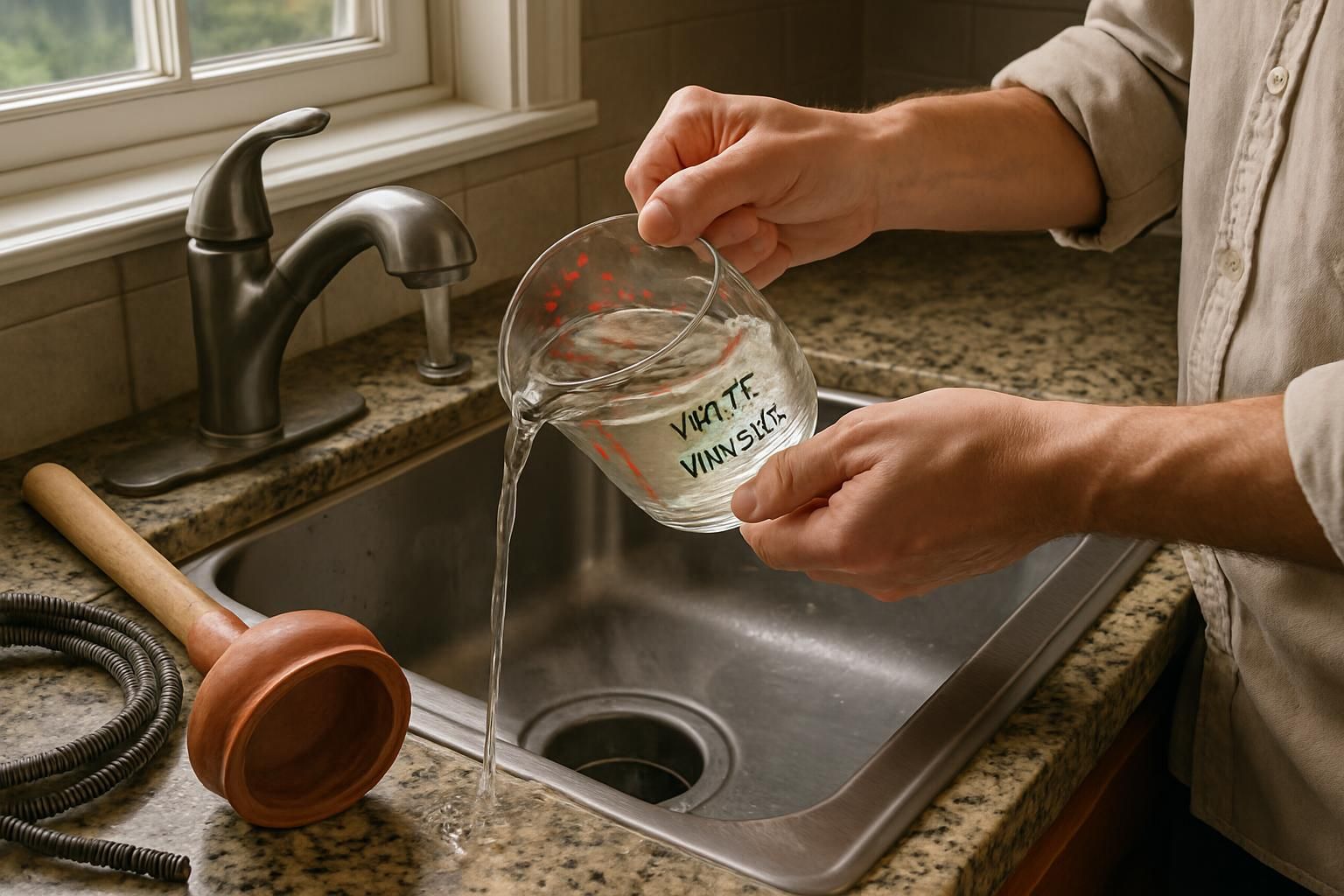
A little care today saves headaches tomorrow, so being proactive can spare hours of hassle. With a few easy tips, homeowners can keep drains clear and running smoothly; here is how to get started.
Use hair catchers
Hair catchers prevent future clogs by trapping hair before it slips down the drain. Two main types exist: internal hair catchers and external screens. Internal ones sit inside the drain, keeping trapped hair hidden from view, while external drain filters or shower drain protectors rest directly over openings to stop debris right away. Many homeowners prefer internal clog blockers because they are easy to install beneath drain covers and keep things looking tidy, though they need cleaning often about once every week to remove build-up. External water drain hair catchers offer simpler maintenance; users simply lift them up after showers and discard the collected debris.
Perform regular maintenance cleaning
Performing regular maintenance cleaning helps keep drains flowing smoothly and saves homeowners headaches down the road. Brushing hair before stepping into the shower cuts down on loose strands heading for trouble, while pouring boiling water weekly down metal pipes melts away soap scum buildup. A steady household cleaning routine with easy actions like these supports good plumbing care and reduces surprise clogs. Making a habit of preventative maintenance also means less frequent plunging or snaking, freeing up valuable family time and keeping everyone smiling at bath time.
Tips for Reducing Shower Drain Odors
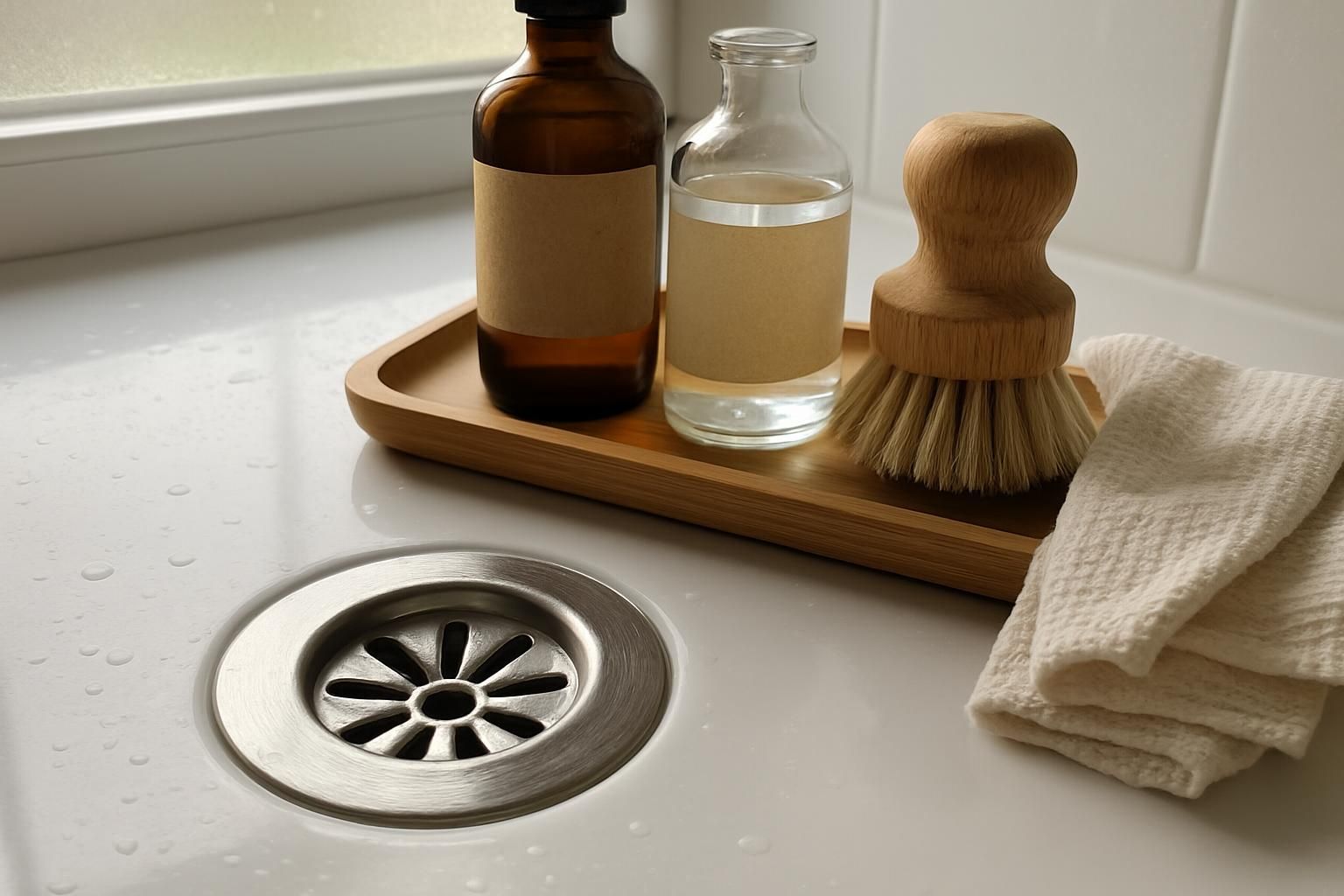
Nobody enjoys a smelly shower drain, so tackling odors quickly keeps the bathroom fresh. With some simple ecofriendly habits, it is easy to ditch unwanted smells for good curious how?
Flush with hot water weekly
Hot water works wonders in reducing drain odors. Performing a weekly hot water flush helps dissolve soap scum and small buildups inside shower drains. This regular hot water treatment also prevents clogs from developing, blocking odors before they begin. In guest bathrooms, running the shower monthly offers extra plumbing maintenance benefits. Regular use stops P-traps beneath the shower from drying out, keeping smells away while preventing plumbing issues down the road. Both weekly and monthly treatments ensure healthier and fresher-smelling home drainage systems for homeowners and parents alike.
Use natural deodorizing solutions
Flushing drains weekly helps, but natural deodorizing solutions offer extra protection for eliminating shower drain odors. Baking soda and vinegar make an effective homemade drain cleaner to neutralize unpleasant odors without harsh chemicals. Pour 1 cup of baking soda down the drain, followed by 1 cup of vinegar; let it fizz a bit, then flush thoroughly with hot water. These ecofriendly odor solutions safely kill bacteria lurking inside household plumbing and create fresher-smelling bathrooms ideal nontoxic drain cleaning methods for families who prefer DIY drain unclogging over chemical alternatives.
Conclusion
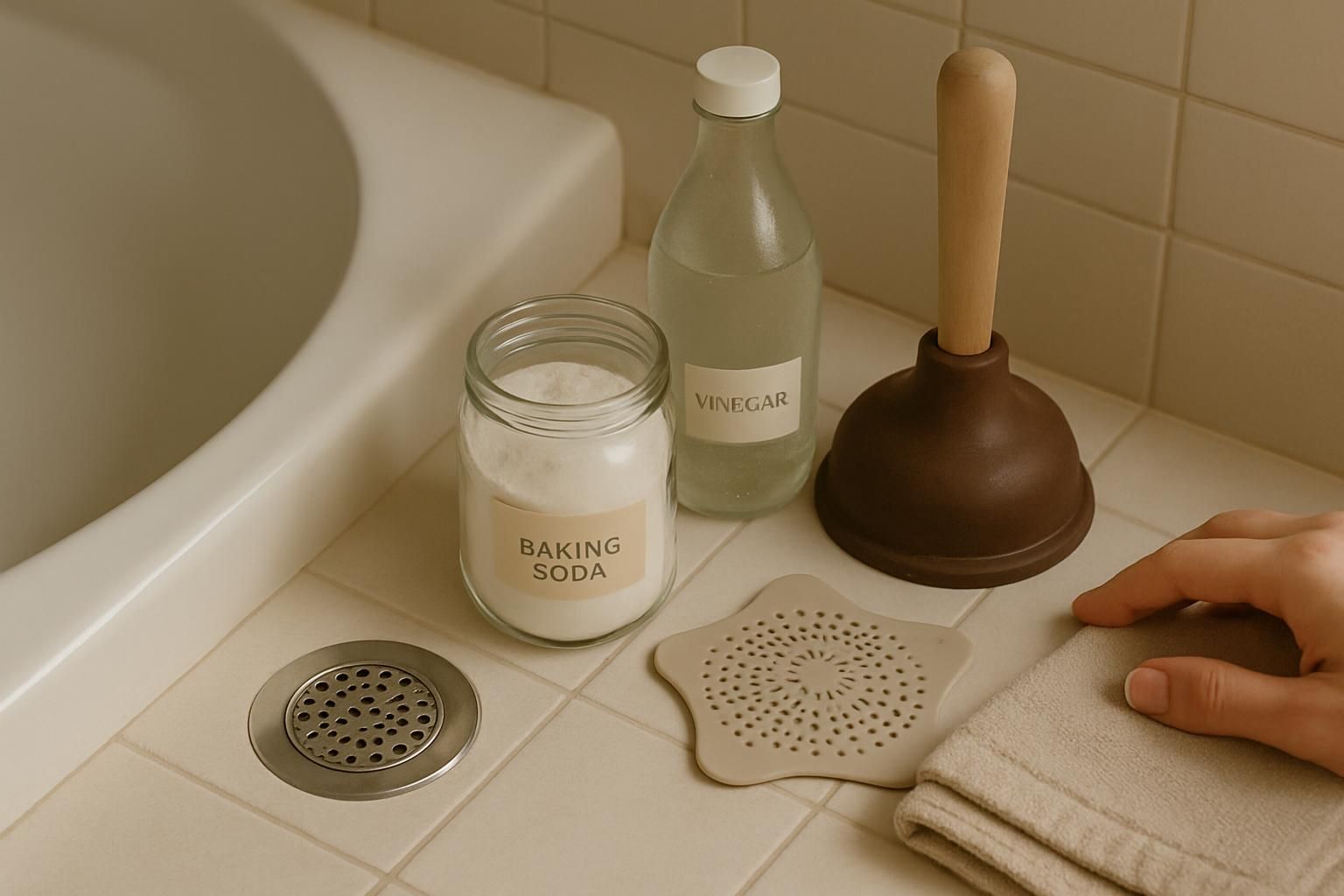
Keeping shower drains clear without harsh chemicals is simple and kind to the environment. Using natural items like baking soda, vinegar, hot water, or a plunger can safely break down clogs and improve drain flow.
Adding hair catchers and cleaning regularly also help keep buildup at bay. These gentle methods protect pipes from damage while keeping showers fresh good news for families aiming for eco-friendly homes.
FAQs
1. Can I clean my shower drain without harsh chemicals?
Absolutely! You can unclog your shower drain using baking soda, vinegar, and hot water. These natural ingredients dissolve grime and hair buildup safely.
2. How often should I naturally clean the shower drain to prevent clogs?
Aim for once a month to keep things flowing smoothly. Regular cleaning with gentle methods prevents stubborn blockages later on.
3. What household items work best for clearing drains without strong cleaners?
Baking soda, white vinegar, boiling water, or even a simple plunger usually do the trick nicely. They are safe alternatives that will not harm pipes or irritate skin.
4. Is it effective to use hot water alone when cleaning out a clogged shower drain?
Hot water helps loosen soap scum and minor debris, but it might not suffice for tougher clogs like tangled hairballs. Pairing it with baking soda and vinegar offers better results every time.
Disclosure: Some links on this page are affiliate links. The recommendations and techniques presented here are based on research from reputable sources and practical experience with eco-friendly drain unclogging methods. All information is provided as a guide for natural drain cleaning and safe alternatives for clearing drains.


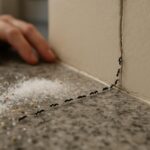



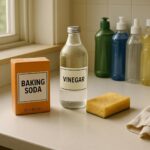
Recent Comments